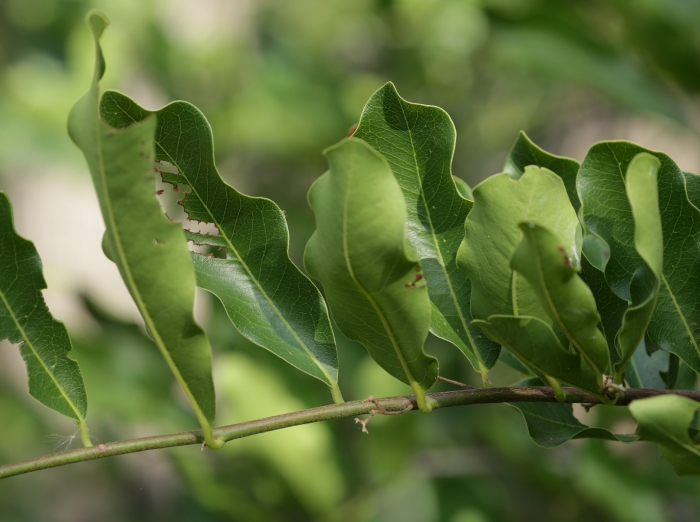Jackalberry
(Diospyros mespiliformis)
Jackalberry (Diospyros mespiliformis)
/
/

Wynand Uys
CC BY 4.0
Image By:
Wynand Uys
Recorded By:
Copyright:
CC BY 4.0
Copyright Notice:
Photo by: Wynand Uys | License Type: CC BY 4.0 | License URL: http://creativecommons.org/licenses/by/4.0/ | Rights Holder: Wynand Uys | Publisher: iNaturalist | Date Created: 2022-12-16T14:15:47-08:00 |

























Estimated Native Range
Summary
Diospyros mespiliformis, commonly known as Jackalberry or African Ebony, is a large dioecious evergreen tree predominantly found in the savannas and occasionally in riverine forests across Africa. It can reach heights of up to 82 feet (25 meters) with a dense, rounded to spreading canopy. The bark is dark gray and deeply fissured, providing a distinctive texture. The foliage consists of glossy, dark green leaves that offer a lush appearance. Cream-colored, inconspicuous flowers appear during the rainy season, and the female trees produce fruits in the dry season. These fruits are oval-shaped and turn yellow or purple when ripe, providing a source of food for various wildlife and are also edible for humans.
Jackalberry trees are valued for their hard, termite-resistant wood, which is utilized in making durable wood floors and high-quality furniture. In cultivation, they are often used as shade trees in large landscapes or as focal points in botanical gardens. They thrive in full sun and can tolerate a range of soil types, provided they are well-drained. While they are drought-tolerant once established, they benefit from regular watering during prolonged dry periods. Gardeners should note that due to its size and root system, it should be planted with ample space from structures.CC BY-SA 4.0
Jackalberry trees are valued for their hard, termite-resistant wood, which is utilized in making durable wood floors and high-quality furniture. In cultivation, they are often used as shade trees in large landscapes or as focal points in botanical gardens. They thrive in full sun and can tolerate a range of soil types, provided they are well-drained. While they are drought-tolerant once established, they benefit from regular watering during prolonged dry periods. Gardeners should note that due to its size and root system, it should be planted with ample space from structures.CC BY-SA 4.0
Plant Description
- Plant Type: Tree
- Height: 15-60 feet
- Width: 20-50 feet
- Growth Rate: Slow
- Flower Color: White, Yellow
- Flowering Season: Spring, Summer
- Leaf Retention: Evergreen
Growth Requirements
- Sun: Full Sun
- Water: Medium
- Drainage: Medium, Fast
Common Uses
Bird Garden, Butterfly Garden, Edible*Disclaimer: Easyscape's listed plant edibility is for informational use. Always verify the safety and proper identification of any plant before consumption., Low Maintenance
Natural Habitat
Predominantly found in the savannas and occasionally in riverine forests across Africa
Other Names
Common Names: Jackalberry, Rhodesian Ebony, Kafifi Katembo, Mufifi, Mufituamuzi, Mutomu, Tchumu, African Ebony, Cape Ebony
Scientific Names: , Diospyros mespiliformis, Diospyros bicolor, Diospyros corylicarpa, Diospyros holtzii, Diospyros kilimandscharica, Diospyros mespiliformis, Diospyros sabiensis, Diospyros senegalensis, Diospyros senegalensis,
GBIF Accepted Name: